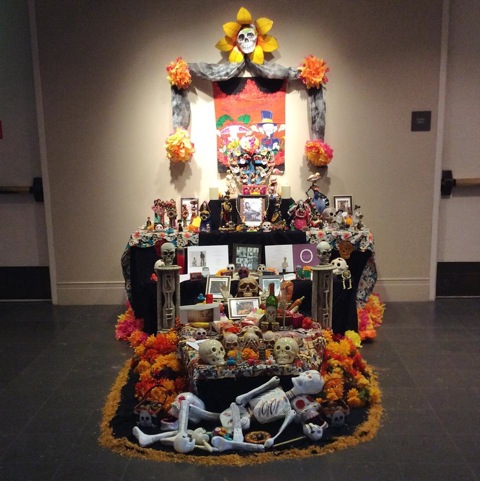The Dead Walk Among Us: An Altar for George Dureau
Taylor Murrow reviews Cynthia Ramirez's commemorative altar for George Dureau on display at the Ogden.

Photo of Cynthia Ramirez's Day of the Dead Altar on view at the Ogden Museum of Southern Art, New Orleans.
Cynthia Ramirez
Ogden Museum of Southern Art
925 Camp Street
September 24–November 10, 2014
For artist Cynthia Ramirez, the process of building an altar begins when she decides whom it will honor. “As soon as I make the selection, I begin to research the person,” she says. “I look into their background: what they liked, including food and drink. I look for photographs of them throughout their life and I incorporate personal items as well.”
Her altar, currently on view at the Ogden Museum of Southern Art, pays tribute to George Dureau, the beloved local artist who passed away in April of this year. It includes bursting orange and yellow marigolds and decorated calacas (skeletons) and calaveras (skulls) of varying shapes and sizes. Carefully placed tokens offer glimpses into Dureau’s life: paint brushes and charcoal, letters that he wrote, and photos of the artist and his work. Boxes of jambalaya, red beans and rice, a wine bottle, and bowls overflowing with vibrantly colored fruits and vegetables are fitting tributes to the artist who loved cooking elaborate feasts for his loved ones.
Day of the Dead traditions are rooted in pre-Columbian history, perhaps some of the oldest celebrations in the Americas, observed by those who understood death to be an inevitable rebirth instead of a finite end. Any New Orleanian who has ever attended a jazz funeral will find this relatable. When “Uncle” Lionel Batiste passed away in 2012, his family rejected the idea of displaying the Treme Brass Band drummer in a wooden casket, instead opting to prop his embalmed body up against a fake light post—his body dressed in a fine suit and trademark gold watch. With his bass drum at his side, Uncle Lionel’s physical remains observed the mourners commemorating his life with brass bands, beer, and food.
While Ramirez’s altar most readily engages Mexican Day of the Dead traditions, New Orleans’ Caribbean influences connect the work to Haitian Voodoo practices. In Voodoo, the Day of the Dead is a time of comfort, to visit grave sites and reconnect with the deceased. Celebrations like those for Uncle Lionel do more than just honor our deceased loved ones; they allow us to openly confront and embrace the inevitable fact that death awaits us all. Perhaps this is why Day of the Dead celebrations have grown increasingly popular in New Orleans. While not comparable to life in ancient Mexico, surviving another year in New Orleans can be cause for rejoicing.
“When I started celebrating the Day of the Dead in New Orleans over 20 years ago, it was hard to get people to understand it,” says Ramirez. Today, she thinks the holiday’s presence in the city has grown in part because of the influx of Latinos after Hurricane Katrina. One might also attribute the growth to the storm itself—when great loss gave way to acceptance and a citywide recognition of resilience.
Ramirez adds, “I always find that children are more receptive to this tradition, and some people believe this is because children are closer to the ‘other side’ because they are new here on earth. I think it just fits perfectly in this city, because of how we treat and honor our dead.”



